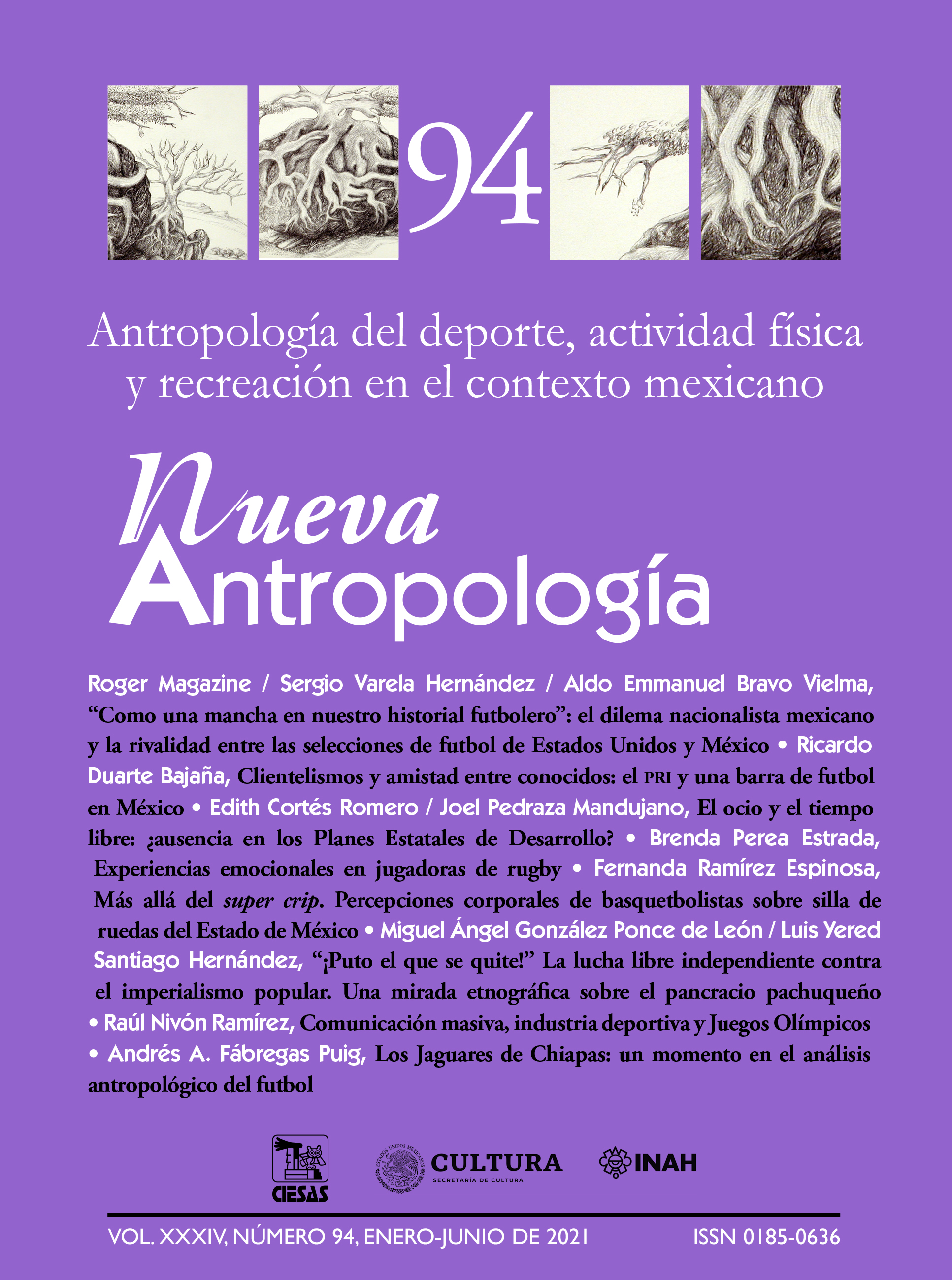Beyond the Super Crip. Body Perceptions of Wheelchair Basketball Players from the State of Mexico
Keywords:
body, sport, super crip, disability.Abstract
The article presents the conformation of adapted sport and the paradox that this implies: on the one hand, the integration of subjects with disabilities to "normalizing" spaces and, on the other hand, disability as the element that sustains the existence of sport and the Paralympic movement. In this scenario, the super crip sports is a media figure whose message focuses on blurring the difference based on the "overcoming" of disability. Through the ethno- graphic work with the "Diablos" -a wheelchair basketball team- it is recognized that the figure of the super crip is part of the life of these actors; however, inhabiting the court entails the reappropriation and recognition of the corporeal mosaic that shapes the group.
Downloads
References
ABU-LUGHOD, Lila (2006), “Interpretando la(s) cultura(s) después de la televisión: sobre el método", Íconos. Revista de Ciencias Sociales, núm. 24, Quito, FLACSO, pp. 119·141.
ACUÑA, Ángel (2001), “El cuerpo en la interpretación de las culturas", Boletín Antropológico, vol. 1, núm. 50, Universidad de los Andes, pp, 31-52.
BARNES, Colin (2009), “Un chiste ‘malo’: rehabilitar a las personas con discapacidad en una sociedad que discapacita", en Patricia BROGNA (comp.), Visiones y revisiones de la discapacidad, México, FCE, pp. 101-123.
BARRETO, Carmen (2006), “Arquitectura corporal. Pasiones deportivas e identificaciones estéticas”, Revista de Dialectología y Tradiciones Populares, vol. LXI, núm. 2, pp. 59-77.
BRITTAIN, Ian (2016), The Paralympic Games Explained, 2ª ed., Nueva York, Routled- ge, pp. 52-128.
CAGIGAL, José M. (1983), “El cuerpo y el deporte en la sociedad Moderna", Papers. Revista de Sociología, núm. 20, Barcelona, pp. 145-156.
ESPEITX, Elena (2006), “Práctica deportiva, alimentación y construcción del cuerpo", Revista Pueblos y Fronteras Digital, núm. 2, pp. 1-21, recuperado en: <http://www.redalyc.org/pdf/906/90600203.pdf>, consultada el 15 de abril de 2020.
FERRANTE, Carolina (2013), “Cuerpo, deporte y discapacidad motriz en la ciudad de Buenos Aires. Tensiones entre la reproducción y el cuestionamiento a la dominación", Revista Española de Discapacidad, vol. 1, núm. 1, pp. 159-178.
_____(2014), “Cuerpo, discapacidad y estigma en el origen del campo del deporte adaptado de la ciudad de Buenos Aires, 1950-1961: ¿una mera interiorización de una identidad devaluada?", História, Ciencias, Saúde-Manguinhos, vol. 21, núm. 2, Río de Janeiro, abril- junio, pp. 421-437.
FRENCH, L. y J. LE CLAIR (2018), “Game Changer? Social Media, Representations of Disability and the Paralympic Games", en l. BRITTAIN y A. BEACOM (eds.), The Palgrave Handbook of Paralympic Studies, 1ª ed., Reino Unido, Palgrave Macmillan, pp. 99-117.
GARCÍA-SANTESMASES, Andrea (2017), “Cuerpos (im)pertinentes: un análisis queercrip de las posibilidades de subversión desde la diversidad funcional", tesis de doctorado, Universitat de Barcelona, Barcelona.
GILBERT, Keith y Otto J. SCHANTZ (2008), The Paralympic Games: Empowerment or Side Show? 1a. ed., Reino Unido, Meyer & Meyer Sport, pp. 254.
GOFFMAN, Erving (2009), Estigma. La identidad deteriorada, España, Amorrortu.
HOWE, David (2008), The Cultural Politics of the Paralympic Movement, Nueva York, Routledge.
MAIKA, Melinda A. (2014), “The ‘Other’ Athletes: Representations of Disability in Canadian Print Media during the London 2012 Paralympic Games”, tesis de maestría en humanidades, The University of Western Ontario.
MANDELL, Richard (1986), Historia cultural del deporte, 1ª ed., España, Ballaterra. MAREÑO, Mauricio y Fernanda MASUERO (2010), “La discapacidad social del ‘diferente"", en Intersticios. Revista Sociológica del Pensamiento Crítico, vol. 4, Argentina.
MARTÍN-BARBERO, Jesús y Sara CORONA BERKIN (2017), Ver con los otros. Comunicación intercultural, México, FCE.
PAPPOUS, A., A. MARCELLINI, E. DE LESELUC et al., (2009), “La representación mediá- tica del deporte adaptado a la discapacidad en los medios de comunicación", Ágora para la Educación Física y el Deporte, núm. 9, pp. 31-42.
PEERS, Danielle (2018), “Sport and Social Movements by and for Disability and Deaf Communities: lmportant Differences in Self-Determination, Politicisation, and Activism", en l. BRITTAIN y A. BEA- COM (eds.), The Palgrave Handbook of Paralympic Studies, 1ª ed., Reino Unido, Palgrave Macmillan, pp. 71-99.
RAMÍREZ, Fernanda (2019), “Los Diablos sobre ruedas. La práctica sociocultural del cuerpo en torno al deporte", tesis de licenciatura, ENAH, México.
SILVA, Carla F. y P. David HOWE (2012), "The (ln)validity of Supercrip Representation of Paralympian Athletes", Journal of Sport and Social Issues, vol. 36, núm. 2, pp. 174-194.
VERGARA, Abilio (2013), Etnografía de los lugares. Una guía antropológica para estudiar su concreta complejidad, 1ª ed., México, INAH/Ediciones Navarra.



